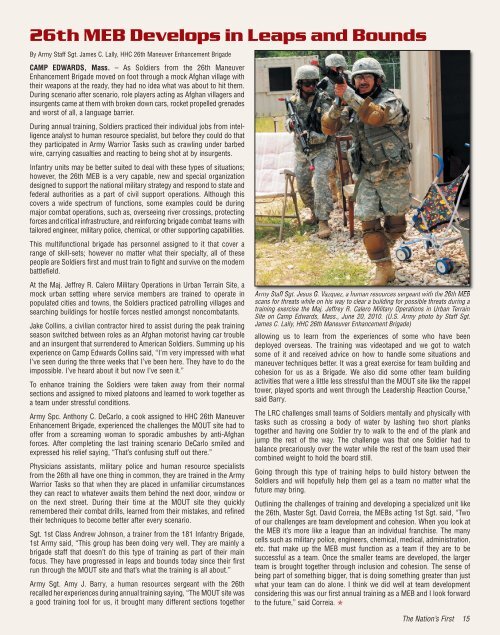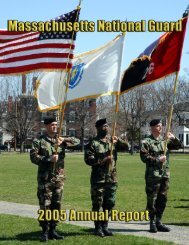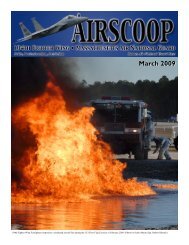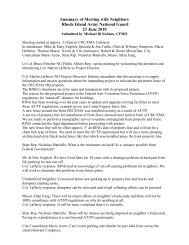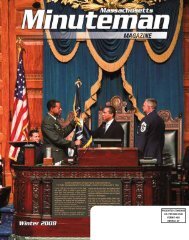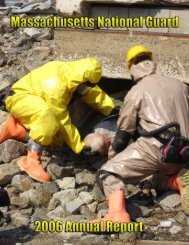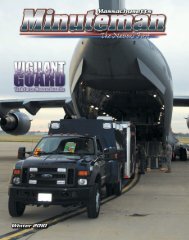Massachusetts Minuteman - Fall 2010 - STATES - The National Guard
Massachusetts Minuteman - Fall 2010 - STATES - The National Guard
Massachusetts Minuteman - Fall 2010 - STATES - The National Guard
Create successful ePaper yourself
Turn your PDF publications into a flip-book with our unique Google optimized e-Paper software.
26th MEB Develops in Leaps and Bounds<br />
By Army Staff Sgt. James C. Lally, HHC 26th Maneuver Enhancement Brigade<br />
CAMP EDWARDS, Mass. – As Soldiers from the 26th Maneuver<br />
Enhancement Brigade moved on foot through a mock Afghan village with<br />
their weapons at the ready, they had no idea what was about to hit them.<br />
During scenario after scenario, role players acting as Afghan villagers and<br />
insurgents came at them with broken down cars, rocket propelled grenades<br />
and worst of all, a language barrier.<br />
During annual training, Soldiers practiced their individual jobs from intelligence<br />
analyst to human resource specialist, but before they could do that<br />
they participated in Army Warrior Tasks such as crawling under barbed<br />
wire, carrying casualties and reacting to being shot at by insurgents.<br />
Infantry units may be better suited to deal with these types of situations;<br />
however, the 26th MEB is a very capable, new and special organization<br />
designed to support the national military strategy and respond to state and<br />
federal authorities as a part of civil support operations. Although this<br />
covers a wide spectrum of functions, some examples could be during<br />
major combat operations, such as, overseeing river crossings, protecting<br />
forces and critical infrastructure, and reinforcing brigade combat teams with<br />
tailored engineer, military police, chemical, or other supporting capabilities.<br />
This multifunctional brigade has personnel assigned to it that cover a<br />
range of skill-sets; however no matter what their specialty, all of these<br />
people are Soldiers first and must train to fight and survive on the modern<br />
battlefield.<br />
At the Maj. Jeffrey R. Calero Military Operations in Urban Terrain Site, a<br />
mock urban setting where service members are trained to operate in<br />
populated cities and towns, the Soldiers practiced patrolling villages and<br />
searching buildings for hostile forces nestled amongst noncombatants.<br />
Jake Collins, a civilian contractor hired to assist during the peak training<br />
season switched between roles as an Afghan motorist having car trouble<br />
and an insurgent that surrendered to American Soldiers. Summing up his<br />
experience on Camp Edwards Collins said, “I’m very impressed with what<br />
I’ve seen during the three weeks that I’ve been here. <strong>The</strong>y have to do the<br />
impossible. I’ve heard about it but now I’ve seen it.”<br />
To enhance training the Soldiers were taken away from their normal<br />
sections and assigned to mixed platoons and learned to work together as<br />
a team under stressful conditions.<br />
Army Spc. Anthony C. DeCarlo, a cook assigned to HHC 26th Maneuver<br />
Enhancement Brigade, experienced the challenges the MOUT site had to<br />
offer from a screaming woman to sporadic ambushes by anti-Afghan<br />
forces. After completing the last training scenario DeCarlo smiled and<br />
expressed his relief saying, “That’s confusing stuff out there.”<br />
Physicians assistants, military police and human resource specialists<br />
from the 26th all have one thing in common, they are trained in the Army<br />
Warrior Tasks so that when they are placed in unfamiliar circumstances<br />
they can react to whatever awaits them behind the next door, window or<br />
on the next street. During their time at the MOUT site they quickly<br />
remembered their combat drills, learned from their mistakes, and refined<br />
their techniques to become better after every scenario.<br />
Sgt. 1st Class Andrew Johnson, a trainer from the 181 Infantry Brigade,<br />
1st Army said, “This group has been doing very well. <strong>The</strong>y are mainly a<br />
brigade staff that doesn’t do this type of training as part of their main<br />
focus. <strong>The</strong>y have progressed in leaps and bounds today since their first<br />
run through the MOUT site and that’s what the training is all about.”<br />
Army Sgt. Amy J. Barry, a human resources sergeant with the 26th<br />
recalled her experiences during annual training saying, “<strong>The</strong> MOUT site was<br />
a good training tool for us, it brought many different sections together<br />
Army Staff Sgt. Jesus G. Vazquez, a human resources sergeant with the 26th MEB<br />
scans for threats while on his way to clear a building for possible threats during a<br />
training exercise the Maj. Jeffrey R. Calero Military Operations in Urban Terrain<br />
Site on Camp Edwards, Mass., June 20, <strong>2010</strong>. (U.S. Army photo by Staff Sgt.<br />
James C. Lally, HHC 26th Maneuver Enhancement Brigade)<br />
allowing us to learn from the experiences of some who have been<br />
deployed overseas. <strong>The</strong> training was videotaped and we got to watch<br />
some of it and received advice on how to handle some situations and<br />
maneuver techniques better. It was a great exercise for team building and<br />
cohesion for us as a Brigade. We also did some other team building<br />
activities that were a little less stressful than the MOUT site like the rappel<br />
tower, played sports and went through the Leadership Reaction Course,”<br />
said Barry.<br />
<strong>The</strong> LRC challenges small teams of Soldiers mentally and physically with<br />
tasks such as crossing a body of water by lashing two short planks<br />
together and having one Soldier try to walk to the end of the plank and<br />
jump the rest of the way. <strong>The</strong> challenge was that one Soldier had to<br />
balance precariously over the water while the rest of the team used their<br />
combined weight to hold the board still.<br />
Going through this type of training helps to build history between the<br />
Soldiers and will hopefully help them gel as a team no matter what the<br />
future may bring.<br />
Outlining the challenges of training and developing a specialized unit like<br />
the 26th, Master Sgt. David Correia, the MEBs acting 1st Sgt. said, “Two<br />
of our challenges are team development and cohesion. When you look at<br />
the MEB it’s more like a league than an individual franchise. <strong>The</strong> many<br />
cells such as military police, engineers, chemical, medical, administration,<br />
etc. that make up the MEB must function as a team if they are to be<br />
successful as a team. Once the smaller teams are developed, the larger<br />
team is brought together through inclusion and cohesion. <strong>The</strong> sense of<br />
being part of something bigger, that is doing something greater than just<br />
what your team can do alone. I think we did well at team development<br />
considering this was our first annual training as a MEB and I look forward<br />
to the future,” said Correia. ✯<br />
<strong>The</strong> Nation’s First 15


